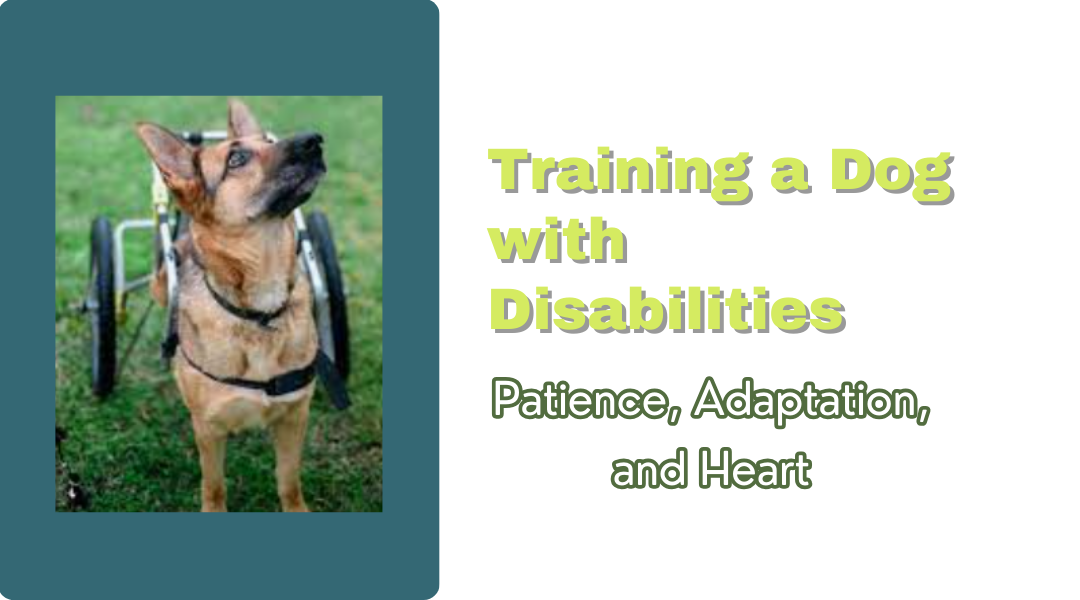Training any dog takes work. But when your pup has special needs, whether from age, injury, or something they were born with, the game changes. You’re not just teaching “sit” and “stay.” You’re learning their language, working around their limits, and celebrating tiny victories that most dog owners take for granted.
The good news? Dogs with disabilities aren’t broken. They just need a different approach—one that’s heavy on patience, light on frustration, and tailored to what they can do. Here’s how to help them thrive.
1. Ditch Punishment—Reward Everything That Works
Positive reinforcement isn’t just nice; it’s necessary for dogs with disabilities. Scolding a blind dog for bumping into furniture or yelling at a deaf dog for not responding? Pointless. Instead:
- Treat like it’s a party. Tiny, soft treats (think shredded chicken or cheese bits) work wonders. For dogs with dietary issues, use their kibble or a favorite toy.
- Celebrate the small stuff. Did your arthritic senior dog shift their weight to sit? Did your anxious pup make eye contact? Throw a praise parade. Progress is progress.
2. Routine is Their Safety Net
Dogs with disabilities cling to predictability. Surprises—like rearranged furniture or a new walking route—can stress them out.
- Keep training sessions short and sweet. Five focused minutes beat 20 minutes of confusion.
- Use the same cues every time. If you’re teaching a deaf dog “down,” stick to one clear hand signal—not three different ones.
3. Work With Their Disability, Not Against It
Blind dogs:
- Use sound and scent. Tap the floor to guide them, or rub a treat on your hand so they can sniff their way to you.
- Avoid moving furniture. Their mental map of the house is their GPS.
Deaf dogs:
- Hand signals + exaggerated facial expressions. A big smile and thumbs-up can mean “Good job!” just as clearly as a spoken “yes!”
- Flashing lights (like a porch light flicked on/off) can replace verbal recall cues.
Dogs with mobility issues:
- Modify commands. If “sit” hurts, try “chin rest” (placing their head on your hand) instead.
- Use ramps, carpets, or harnesses. A rug over slick floors helps wobbly pups gain traction.
4. Fix the Problem, Not Just the Behavior
A “stubborn” dog might actually be:
- In pain (arthritis, dental issues)
- Overwhelmed (too much noise, new people)
- Confused (cognitive decline in seniors)
Example: A once-housebroken senior dog having accidents? Before scolding, rule out UTIs, diabetes, or dementia.
5. Gear That Actually Helps
Skip the cheap, ill-fitting Amazon harnesses. Invest in:
- Support slings for weak hind legs
- Vest harnesses with handles (for guiding blind/deaf dogs)
- Non-slip socks or booties for dogs that drag their paws
6. Senior Dogs Aren’t “Too Old” to Learn
They’re slower, sure. But they still want to engage. Try:
- Nosework games. Hide treats in muffin tins covered with tennis balls. Mental exercise tires them out without joint strain.
- Gentle stretches. Lure them into a “bow” with a treat to keep muscles loose.
The Hardest Truth? You Have to Advocate for Them
The world isn’t built for disabled dogs. Strangers will stare, off-leash dogs will invade their space, and well-meaning friends will say, “Maybe it’s time to…” (you know the rest).
But here’s the thing: A dog who’s loved and understood doesn’t care about “normal.” They care about their person—the one who learns their quirks, cheers for their progress, and doesn’t give up when training takes months instead of days.
So yeah, it’s harder. But watching a deaf dog master hand signals, or a three-legged pup figure out their own way to climb onto the couch? That’s the kind of joy you can’t buy in a pet store.
Bottom line: Meet them where they are. They’ll surprise you with how far they can go.
